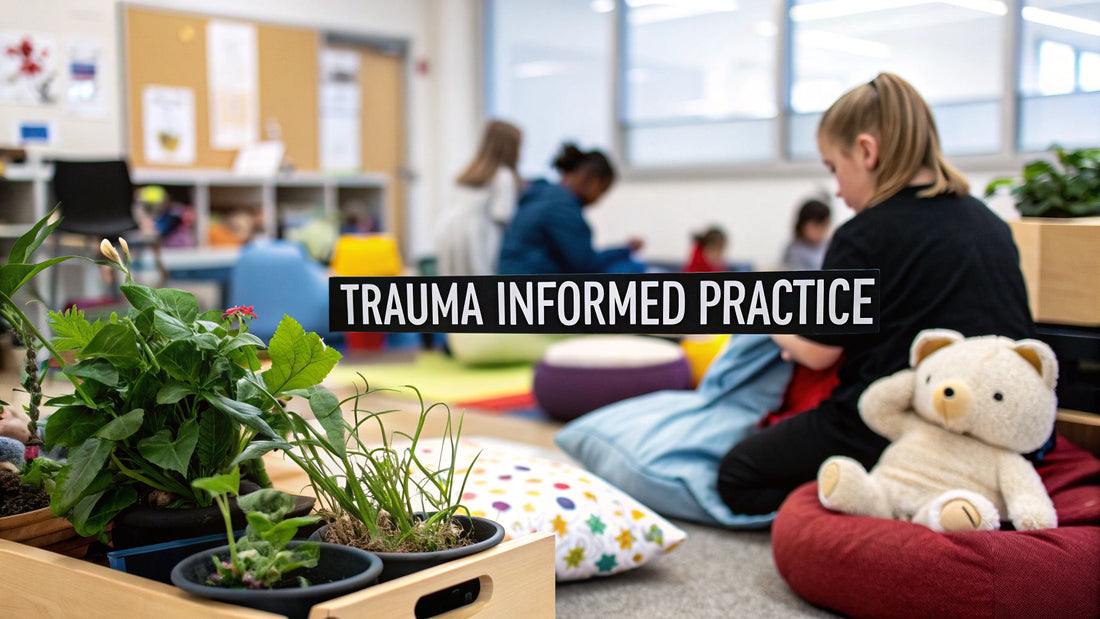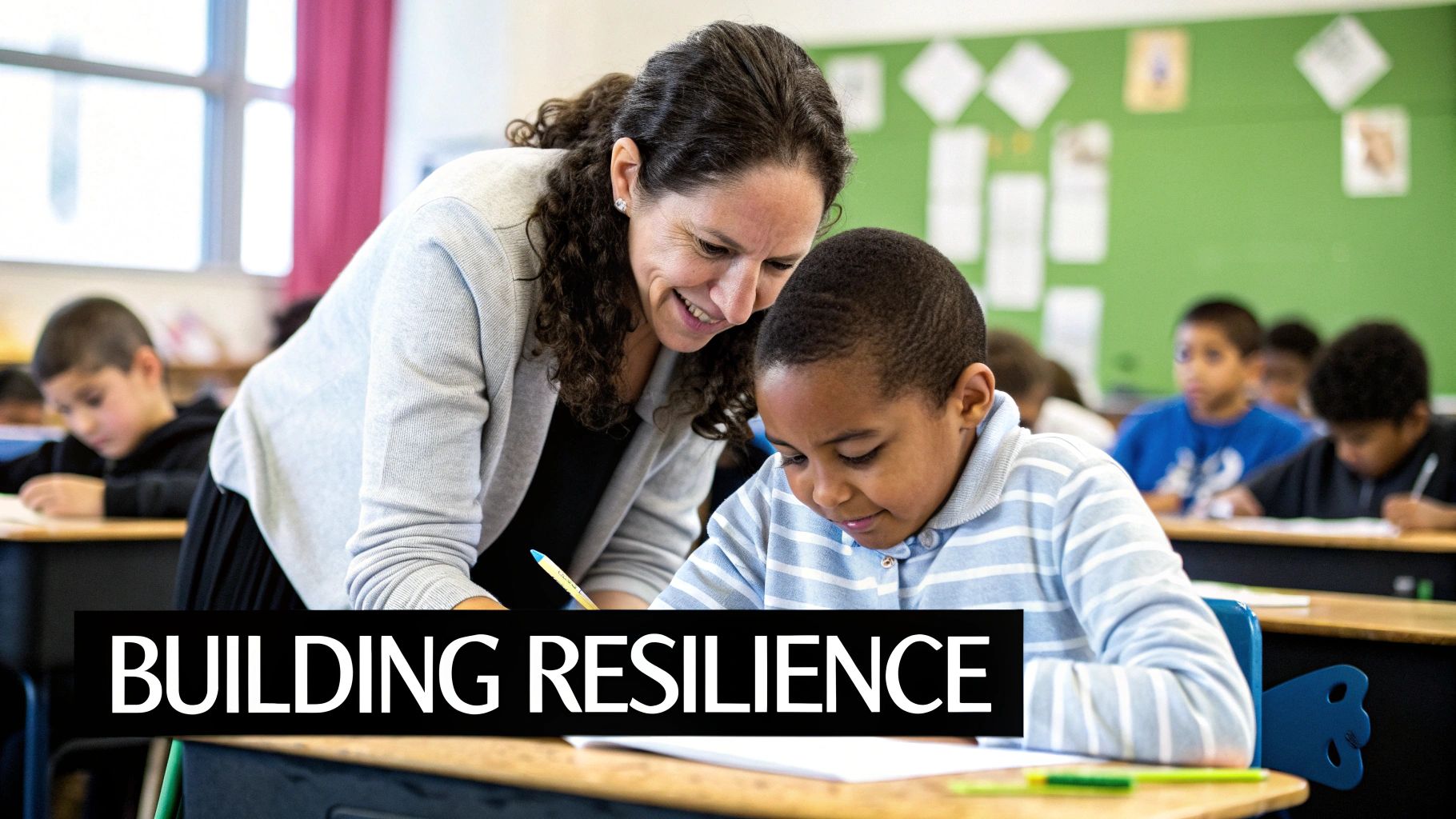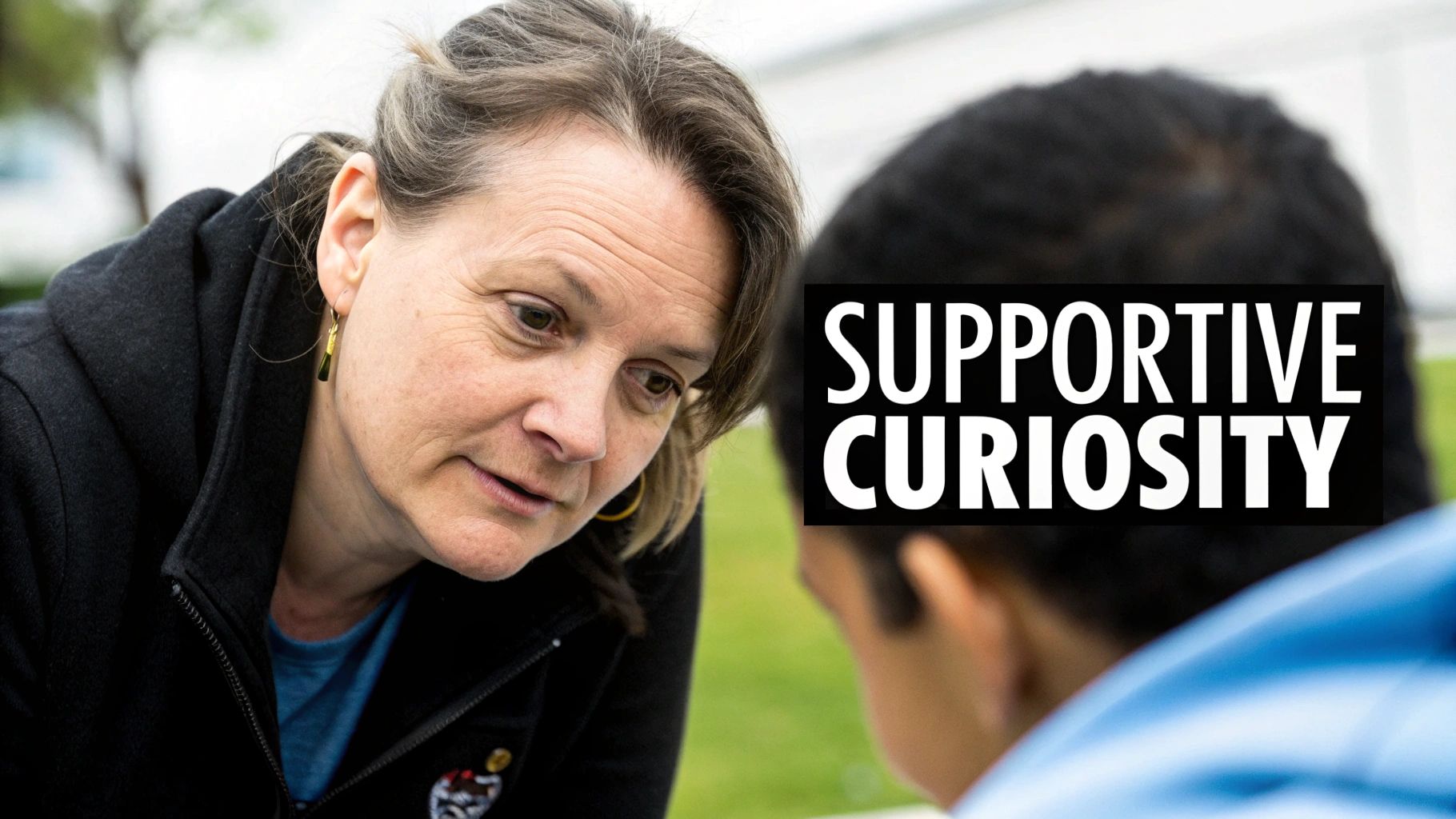
What Is Trauma Informed Practice? Key Principles Explained
Share
Trauma-informed practice marks a fundamental shift in how we understand people and their behaviour. It encourages us to move away from asking "What's wrong with you?" and instead, to ask with genuine curiosity, "What has happened to you?" This simple change in perspective acknowledges that our past experiences, especially traumatic ones, can profoundly shape how we react, behave, and see the world.
The Foundations Of Trauma Informed Practice
At its core, trauma-informed practice isn’t a specific therapy or a rigid set of rules. Think of it more as a new lens through which to view the world—a framework for creating environments where people feel physically and psychologically safe. It starts with the understanding that challenging behaviours are often just coping mechanisms, developed by a person to survive overwhelming events.
When we recognise the widespread impact of trauma, we can start building relationships based on trust and empathy. This helps professionals in any setting—from schools to healthcare—avoid accidentally causing more distress or re-traumatising someone. This approach is built on understanding how trauma affects brain development, particularly in children, and how it can influence health right through a person's life. Instead of focusing on deficits, we learn to see a person's strengths and resilience in the context of what they've been through.
This infographic captures the simple, yet powerful, question that guides this entire approach.

This shift from judgement to curiosity is the bedrock of creating a safe and supportive space. Everything else is built on this foundation.
Adopting a New Perspective
Embracing this way of working means committing to seeing the whole person, not just their behaviour. To really grasp the long-lasting effects of trauma, especially on how we form relationships, resources on topics like attachment issues and disorders in adults can be incredibly insightful. This knowledge helps us connect the dots between past experiences and present actions.
While the concept was officially recognised in the United States around 2005, its journey into UK practice has been more gradual. The NHS Long Term Plan of 2019 was a huge step forward, formally endorsing trauma-informed care and signalling a major institutional shift. However, putting it into practice across the board is still a work in progress.
A trauma-informed approach is guided by a set of core principles. These aren't just abstract ideas; they are practical tools that shape every interaction, policy, and procedure to ensure an environment supports healing rather than getting in the way of it.
You can dive deeper into these foundational concepts in our guide exploring what is trauma informed care. Next up, we’ll break down the six core principles that guide this practice, giving you a clear roadmap for putting these ideas into action. It is important to remember this guide is for informational purposes; if you have personal concerns, please consult your GP or a qualified mental health professional.
The Six Guiding Principles in Action
To really get to grips with what trauma-informed practice is, we need to see how its principles play out in the real world. It’s one thing to talk about the theory, but these six guiding principles are actually a practical framework for creating safe and supportive environments. They shape every single interaction, whether in a classroom or a GP surgery, making sure our actions genuinely help people heal.
The six principles are: Safety, Trustworthiness, Peer Support, Collaboration, Empowerment, and Cultural Sensitivity. Think of each one as a promise to see the whole person and understand how their experiences have shaped them.
Let’s dig into what these look like day-to-day.
Safety and Trustworthiness
The very first principle, Safety, is all about creating a space where people feel secure, both physically and emotionally. In a school, that might mean keeping the hallways calm and monitored. But just as important is psychological safety—a child knowing they won’t be shamed or embarrassed if they get something wrong. For example, a teacher might create a "mistakes are for learning" culture where trying is celebrated more than getting the right answer.
Trustworthiness and Transparency build right on top of that foundation. This is simply about being clear, consistent, and doing what you say you’ll do. Picture a GP surgery where a nurse calmly explains every step of a check-up to a nervous teenager, so there are no surprises. That kind of open, steady communication builds confidence and melts away anxiety.
Peer Support and Collaboration
Peer Support is a powerful one. It taps into the huge value of shared experiences. When you realise you’re not the only one who feels a certain way, it creates a powerful sense of belonging. A great example is a youth group where older teens mentor younger kids who’ve been through similar struggles. The advice just hits different because it comes from someone who truly "gets it."
In a similar vein, Collaboration and Mutuality helps to level the playing field between professionals and the people they support. Instead of a top-down, "we know best" approach, it’s all about working together. In a care setting, this could be a social worker and a young person sitting down together to map out goals, sharing the power and responsibility.
"A core part of trauma-informed practice is shifting from 'doing to' someone to 'working with' them. This collaborative spirit is essential for building genuine trust and fostering a person's sense of agency."
Empowerment and Cultural Sensitivity
Empowerment, Voice, and Choice is all about handing back a sense of control. Trauma often leaves people feeling completely powerless. Offering simple choices, like "Would you prefer to sit here or by the window?" or including a child in creating their own support plan, helps to restore that feeling of agency. When their voice is heard and valued, it can make a world of difference to their engagement and progress.
Finally, Cultural, Historical, and Gender Issues asks us to remember that everyone’s background shapes how they experience trauma and healing. A support worker who understands the specific cultural pressures a young person is facing can provide much more effective help. This principle makes sure our approach isn't a one-size-fits-all solution but is tailored to the unique context of each person's life.
By weaving these six principles into our daily practice, we can create environments that don't just avoid causing more harm but actively help people heal and build resilience.
Why This Approach Is Vital For Children And Young People
Adopting a trauma-informed approach isn't just a helpful extra for children and young people; it's absolutely essential. Childhood should be a time of growth and discovery, but for many, it's marked by experiences that throw this journey off course. Addressing mental health early is crucial, as one in six children aged 7 to 16 are now estimated to have a probable mental health problem in the UK.
Imagine a young brain is like a house being built. Positive experiences, like feeling safe and loved, create a strong, sturdy foundation. In contrast, Adverse Childhood Experiences (ACEs)—things like neglect, abuse, or living in a chaotic home—are like earthquakes that shake the very structure as it’s being put up. These events can literally interfere with crucial wiring, impacting everything from memory and learning to the ability to manage big feelings.

This isn't just theory; it shows up in real, everyday behaviour. A child who seems constantly disruptive in class might not be trying to be difficult. It could be that their brain's "threat detection" system is stuck on high alert, making it impossible to sit still and focus. In the same way, a teenager who withdraws and shuts down might be using a coping mechanism they learned to feel safe. A trauma-informed approach helps us see the ‘why’ behind the action, so we can respond with support instead of punishment.
The Modern Pressures Affecting Young Minds
Today's world throws some unique challenges into the mix that can make young people even more vulnerable. The digital world, especially social media, can become a source of stress and trauma. There’s constant pressure to present a perfect life, not to mention cyberbullying and exposure to harmful content, all of which can amplify existing insecurities and create brand-new anxieties.
This constant online connection means that the pressure doesn't just stop at the school gate; it follows young people home and into their personal spaces. This is where a trauma-informed lens becomes so important for parents and educators. It allows us to recognise that a sudden change in a child’s mood might be linked to something happening online that they don't feel able to talk about.
The long-term impact of unaddressed childhood trauma is profound and stretches far beyond the school years. The statistics really bring this home. A household survey in England and Wales found that adults who had experienced four or more ACEs were twice as likely to visit their GP repeatedly compared to those with none. This starkly highlights how childhood experiences directly affect adult health and place a huge burden on our health services. You can learn more about these findings by exploring the full research on ACEs and health service use.
Building Resilience For A Brighter Future
The good news is that the brain is adaptable. By creating safe, stable, and nurturing environments, we can help repair those shaky foundations and build resilience. This is the very heart of what trauma-informed practice sets out to do for children and young people.
This approach involves practical, everyday actions that make a massive difference:
- Predictable Routines: Consistent schedules in schools and at home help a child's nervous system feel safe and calm.
- Emotional Co-regulation: Instead of just telling a distressed child to "calm down," an adult sits with them, models deep breathing, and offers quiet, steady support.
- Offering Choices: Simple choices, like "Do you want to read a book or draw a picture?", help restore a sense of control that trauma often takes away.
By building these supportive systems, we are not just managing behaviour; we are actively helping young brains to heal and develop healthy pathways for the future. Understanding effective strategies for providing youth emotional support is a key part of this process, equipping us all with the tools to help young minds flourish.
Ultimately, a trauma-informed approach is a commitment to the next generation. It is a promise to look beneath the surface, to understand the story behind the struggle, and to create the conditions where every child has the chance to feel safe, seen, and supported.
Implementing A Trauma-Informed Approach
Making the shift to a trauma-informed model can feel like a massive undertaking for any organisation. But it’s not about a single grand gesture. It's a journey made up of smaller, practical steps that anyone can take.
It all starts with a genuine commitment from the top. Leadership needs to decide to see the world through a new lens—one that puts understanding and safety first. This commitment is the real engine that powers every other change.
With leadership on board, the next vital piece is staff training that actually means something. This isn't just about getting a certificate or ticking a box. It’s about building real empathy and giving your team practical tools they can use when things get tough. Staff need to understand the 'why' behind challenging behaviours and learn how to respond in ways that calm situations down, instead of making them worse.
Moving From Policy To Practice
Real change happens when the training leaves the conference room and starts shaping day-to-day life. It means taking a hard look at your organisation's policies and procedures and asking a simple but powerful question: "Does this policy help people feel safe and build trust, or could it accidentally cause harm?"
This is where the theory gets real.
For a school, this could completely change how they handle discipline. Instead of a system built on punishment like detentions and exclusions, they might switch to restorative practices. The goal shifts from punishment to repairing harm, understanding the impact of actions, and helping the student become part of the community again. It’s the difference between asking "What rule did you break?" and asking "What happened, and how can we make it right together?"
In a healthcare setting, it might look like changing the way appointments are run. Staff could be trained to give patients more control by offering choices about who is in the room, or by explaining every step of a procedure so there are no scary surprises. This small act of giving someone a choice can turn an experience from one of fear into one of collaboration.
The Business Case For Compassion
While the moral argument for this approach is strong, there’s also a solid business reason to make the switch. Poor mental health has a huge, measurable impact on the UK economy. A 2022 report from Deloitte revealed that the annual cost to UK employers is now estimated to be as high as £56 billion.
That staggering number isn't just a statistic. It represents the real-world costs of high staff turnover, burnout, absenteeism (days off sick), and presenteeism (when staff show up but are too unwell to be productive).
Investing in a supportive, trauma-informed environment isn't just the right thing to do; it's a smart financial decision. When employees feel psychologically safe and looked after, they're more engaged, more productive, and far more likely to stick around. This cuts down on recruitment and training costs and helps build a healthier, more resilient team.
Cultivating A Supportive Culture
Creating a trauma-informed culture is a constant process of learning and adapting. It needs everyone, from the CEO to the newest team member, to be committed to the principles of safety, trust, and empowerment.
Knowing how to spot the signs of distress and respond with compassion is a crucial skill for anyone in a leadership or support role. If you're looking to build these skills, understanding the basics of youth mental health first aid can provide an amazing foundation, especially for supporting younger colleagues or the young people you work with.
By giving staff this knowledge, organisations aren't just improving their services—they're investing in the wellbeing of their entire community. This creates a positive ripple effect that truly benefits everyone involved.
How To Recognise And Respond To Trauma
Putting trauma-informed practice into action isn't about becoming a clinician overnight. It's about developing the skills to spot signs of distress and, crucially, responding with compassion instead of judgement. Seeing the potential signs of trauma is the first step, but it’s so important to remember this isn't a diagnostic checklist. These are simply signals that a child might be struggling.
Behaviour is just a form of communication. When a child's actions seem challenging or just plain confusing, a trauma-informed lens encourages us to get curious. We start to wonder about the story behind the behaviour. Instead of seeing a "naughty" child, we might see a child whose nervous system is completely overwhelmed and just trying to cope.

This shift from reacting to responding is the absolute heart of the practice. It means we have to pause, take a breath, and choose our words and actions carefully so we don't end up making a stressful situation even worse.
Common Signs and Compassionate Responses
Children and young people show us they're distressed in all sorts of ways. While every single person is different, some common indicators might include sudden mood swings, finding it hard to concentrate, being easily startled, pulling away from friends, or even unexplained physical things like headaches. The real key is just noticing a shift from their usual self.
The most powerful tool we have is our response. How we react can either pour fuel on the fire or create a bubble of safety that allows a child to regulate and calm down. It’s all about moving from commands to connection.
For instance, a classic reaction to a child having a meltdown is to say, "Calm down!" While our hearts are in the right place, this often has the exact opposite effect. A more compassionate, trauma-informed response focuses on making them feel seen and supported.
Instead of: "Stop crying, there's nothing to be upset about."
Try: "I can see you're really upset. I'm right here with you."
This simple switch validates their feelings and offers connection, which is what a dysregulated nervous system is crying out for. Here are a few more practical examples of these compassionate swaps:
-
Instead of: "Why did you do that?"
-
Try: "It looks like you were having a really tough time. Can we talk about what happened?"
-
Instead of: "You need to listen to me right now."
-
Try: "I really want to understand what you need. How can I help?"
These phrases aren't magic wands, but they gently open the door for communication rather than slamming it shut with blame or demands.
Practical Relaxation And Grounding Tips
In those moments of high stress, we can actually help a child co-regulate their emotions by guiding them through some simple grounding exercises. These little techniques help pull their focus away from overwhelming feelings and back into the safety of the present moment. They’re simple, quick, and can be done anywhere.
Breathing Techniques to Try:
- Box Breathing: Breathe in slowly for four counts, hold for four counts, breathe out for four counts, and hold again for four counts. Picturing a square in your mind can really help.
- Belly Breathing: Pop a hand on the belly and just feel it rise and fall with each deep breath. This encourages the slower, deeper breathing that naturally calms the nervous system.
Simple Grounding Exercises:
- The 5-4-3-2-1 Method: Ask the child to name five things they can see, four things they can physically feel (like their feet on the floor), three things they can hear, two things they can smell, and one thing they can taste.
- Temperature Change: Simply holding a cool glass of water or splashing a little cool water on their face can provide a quick sensory reset that works wonders.
These relaxation tips are tools for support, not a replacement for professional help. They are about creating little pockets of calm and connection right in the middle of a storm.
Important Disclaimer: I am not a mental health professional. The information provided here is for educational and supportive purposes only. If you are worried about a child’s mental health, it is essential to seek advice from a GP or a qualified mental health practitioner.
Your Next Steps and Further Resources
Getting your head around trauma-informed practice is a massive first step, but the real journey is in continuing to learn and knowing who to turn to for support. It’s not just about professional development; it's about looking after your own wellbeing and fostering open, honest conversations about mental health.
It’s so important to take care of yourself while you’re supporting others. Simple things, like practising a bit of mindful breathing or just making sure you step away from your screen, can make a real difference in managing stress. But remember, these are tools for wellbeing, not a replacement for professional help.
A Quick But Important Note: Please remember, I'm not a mental health professional. Everything in this guide is for educational purposes. If you have any concerns about your own mental health or a child's, it's absolutely vital to speak to a doctor or a qualified mental health practitioner.
UK Mental Health Support Organisations
Knowing where to find reliable help is half the battle. Here are a few trusted UK-based organisations that offer fantastic support for both children and adults:
- Mind: Offers advice and support to empower anyone going through a tough time with their mental health.
- YoungMinds: The UK's leading charity, fighting for the mental health of children and young people.
- NHS Mental Health Services: Your GP is the best starting point for a whole range of support, including CAMHS for children.
For more insights into practices that support children and young people, you can find some great articles and discussions over on the BuddyPro blog.
Continuing Your Learning and Awareness
Reading is a brilliant way to build empathy and really deepen your understanding. Books like The Body Keeps the Score by Bessel van der Kolk offer some profound insights into how trauma truly affects us. For something with a more UK-specific feel, A Little Book of A-Z of C-PTSD by a UK survivor is an accessible and helpful read.
You can also champion the conversation around wellbeing in your everyday life. There are several UK-based mental health apparel brands that donate a portion of their profits to charity. Their designs help normalise these important discussions, offering a simple, practical way to show your support and chip away at the stigma.
A Few Common Questions
As we dig into what trauma-informed practice really means, a few questions tend to pop up again and again. Let's clear up some of the most common ones to give you a more solid understanding of this way of thinking and working.
Is Trauma-Informed Practice Just Another Word For Therapy?
That's a brilliant question, and one a lot of people ask. The short answer is no, but they work together hand-in-glove.
Think of it like this: trauma-informed practice is the safe, sturdy environment—like well-tended soil. Therapy, on the other hand, is a specific intervention, like a specialist plant food designed to help something grow strong after being damaged.
A trauma-informed approach is a blueprint for an entire organisation—a school, a care home, even a business—to shape its culture around safety, trust, and avoiding anything that might re-trigger someone's trauma. Therapy is a clinical treatment carried out by a qualified professional to help one person heal. The two are distinct, but a trauma-informed setting makes it so much safer and easier for a person to get the full benefit of therapy.
Does This Only Work In Schools And Hospitals?
Not at all. While the approach has deep roots in education and healthcare, its principles are universal. They can make a huge difference in any setting where people interact with each other.
Take a corporate workplace, for example. A trauma-informed culture can reduce staff burnout and boost psychological safety, which is a massive deal when you consider poor mental health costs UK businesses billions every year. Even the justice system can benefit, shifting the focus from simply punishing someone to understanding the role trauma might have played in their story. At its heart, it’s about asking "What happened to you?" instead of "What's wrong with you?" – and that question is relevant everywhere.
The biggest challenge isn’t getting people to agree with the idea; it’s getting them to put it into consistent, genuine practice. Moving beyond a one-off training day requires real commitment from the top down to overcome old habits and resistance to change.
So how do you know if it's working? You look at the data, but you also listen to the people. You can track things like a drop in staff turnover or fewer behavioural incidents. But just as important is the qualitative stuff—hearing that staff feel more supported, or that the people you serve feel safer and more respected. That's when you know you're truly making a difference.
At Little Fish Books, we believe in nurturing emotional literacy right from the start. You can explore our range of books, activities, and supportive resources designed to help children and young people understand and manage their feelings in a healthy way. Discover tools for a kinder, more understanding future at https://thatsokay.co.uk.
